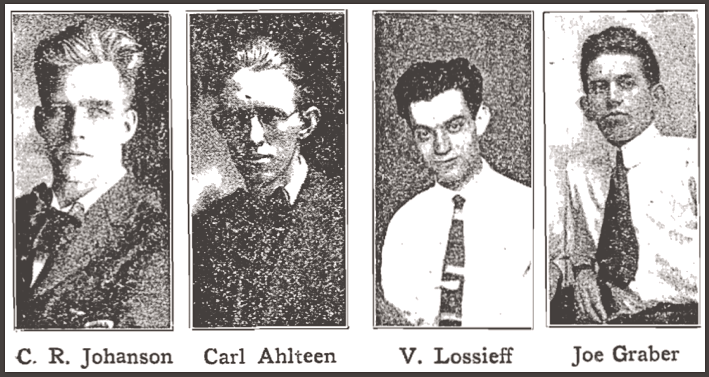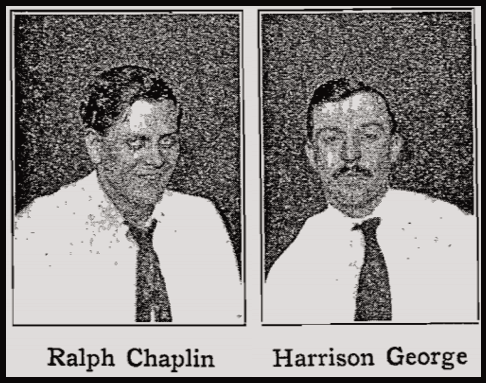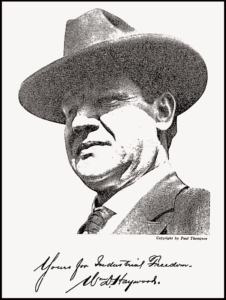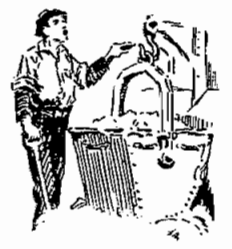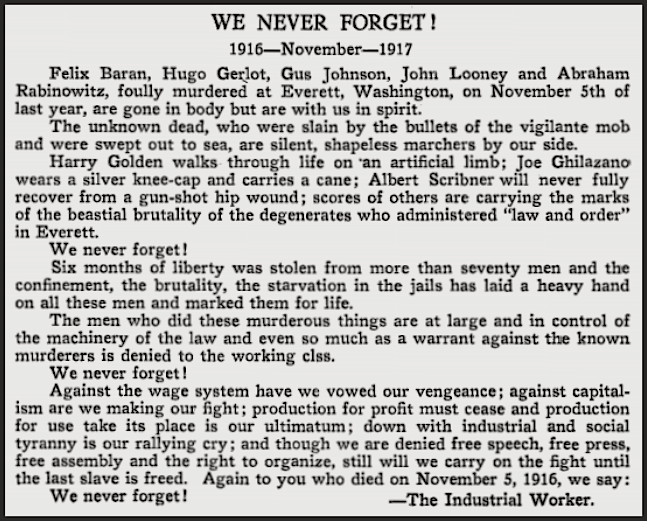If you are a red-blooded worker
you will see that
this fight is your fight.
–International Socialist Review
Hellraisers Journal, Thursday January 3, 1918
Chicago, Illinois – General Defense Committee Appeals for Funds
From the International Socialist Review of January 1918:
“WHERE LIBERTY IS THERE IS MY COUNTRY”
—–
—–
Six of the one hundred and sixty-six socialists and members of the I. W. W. who are indicted on a charge of seditious conspiracy.
Most of the boys are in Cook County or near-by jails as it would take a cash bail of over a million and one-half dollars to secure their liberty.
They belong to the working class and are in jail because they organized and educated the workers to fight for Industrial Democracy.
It will be a class trial. Capitalist interests will demand that these men be convicted and their union legally destroyed. They want the U. S. government to do what their gunmen and governors have failed to do by brute force.
The 166 will be arraigned in Chicago before Judge Kenesaw M. Landis on December 15th and expect to face all the fury of the capitalist class during the trials in January.
If you are a red-blooded worker you will see that this fight is your fight. Start a defense fund going among your fellow workers and do it quick.
General Defense Committee, 1001 West Madison St., Chicago, Ill. Make checks and money orders payable to William D. Haywood.
———-
On Fellow Worker Big Bill Haywood:
HAYWOOD OF THE I. W. W.
By JACK PHILLIPS
OLD John Brown of Ossawattamie was arrested by officers of the United States government, legally indicted, legally tried, and legally shot [hung], as a traitor to the nation. A few short years afterward millions of marching men, soldiers of the United States Army, with Abraham Lincoln for commander-in-chief, marched singing a song with every verse and every chorus glorifying John Brown. And “John Brown’s Body Lies A Mouldering in the Grave” is today the most popular folk song of the American nation. Let the fact be recorded at this time that John Brown was tried on the charge of treason and shot to death because of presumed guilt of treason.
What was it John Brown did that caused him to be remembered and glorified in a national marching song? He was a man with a dream. His mind conceived the vision that if the southern black slaves could be armed with rifles they would fight their way to freedom from their white masters. Therefore, reasoned John Brown, the thing to do is to raid a government arsenal and seize the guns wanted by the black slaves. So he and his sons and followers raided the federal arsenal at Harpers Ferry, were hunted, captured, and as hereinbefore noted, legally indicted, tried, shot.
So Big Bill Haywood, nearly sixty years later, appears in history, another man dominated by a dream. Haywood has a vision of industrial democracy established, a hope of security and justice for all the workers of the world, the shackles of capitalist wage slavery struck off. How is this vision to be attained? Thru a world wide general strike of the working class,” thru mass action of the working people of the world, without violence necessarily, without death penalties, revenges and punitive indemnities. Merely thru a folding of arms, a refusal to make or transport the goods of the world, till all autocracies yielded to a newer order. Such was to be the working of the plan when its details could be arranged.
As wild a dream, perhaps, as the dream of John Brown that arming the southern blacks would lead to the abolition of chattel slavery. As vague and chimerical a vision as that of the “traitor” after whom the nation’s most famous marching song was written.
What it leads to is the question: Will there be marching songs written to Bill Haywood some day as the same kind of a “traitor” as the John Brown who was legally indicted, legally tried, legally shot?
Let Claude Porter, special assistant attorney general in charge of the prosecution of the I. W. W. think about these things.
We wonder today when we look back and read the savage and ruthless charges brought against John Brown by the prosecutors. They called for his blood with tongues that today are dust.
One day Claude Porter’s accusing tongue will be dust. And Big Bill Haywood will be dust. Which of the two will be remembered?
Nobody remembers today who it was that tongue-lashed John Brown in the prosecution of him for treason. But everybody knows the story of John Brown.
So be it. Such is history and the drama of destiny.
———-
[Photograph added.]
A Victory at St. Maries, Idaho:
Winning Out in Idaho
By G. F. VANDERVEER
Chief Counsel for the I. W. W.ON July 13, 1917, the I. W. W. hall at St. Maries, Idaho, was raided by E. B. Nolan, sheriff of Benwah County, all the supplies, literature and correspondence taken without a search warrant and a number of men arrested on a charge of “criminal syndicalism.”
These arrests continued thruout the summer and fall until forty men were in custody, and it became necessary to erect a stockade in the county fairgrounds to provide for their confinement.
The first of these cases came to trial on November 12th, and the State selected as the defendant against whom it had the clearest case, Neil Guiney, secretary of the St. Maries branch. The case against Guiney had been prepared and the arrest made under the personal supervision of Governor Alexander. It was prosecuted by two special “lumber company” prosecutors from Coeur d’Alene, Potts and Wernette. Every attempt was made by the State to secure a prejudiced jury, resort being had to the time-worn expedient of a special venire summoned by a friendly coroner from the streets and countryside. Every fact charged against Guiney was admitted by the defense except that the “organization advocated crime, violence, sabotage and unlawful methods of terrorism as a means of accomplishing political or industrial reform.” And upon this issue alone the case was presented to the jury.
The State had massed its forces for a “test case,” and in order that the case might be a test in the broadest possible sense the defense waived all other questions. After a nine-day trial, with every circumstance against him, the defendant won a comparatively speedy verdict of “Not Guilty.” Why?
Because it was virtually admitted that the lumber trust passed the criminal syndicalism law to strike at the I. W. W., because it was prosecuted by their special attorneys; and finally because it was conclusively proven that the strikes which had been in progress all summer were the most orderly imaginable; that the I. W. W. suppressed all disorder, intoxication and violence and not only did not destroy property but, on the contrary, saved a half million dollars’ worth of timber in Idaho and Montana from destruction by fire. All these facts were generously attested by fire wardens and local peace officers in a manner which left no room for dispute.
Finally the I. W. W. proved conclusively not only that it did not advocate violence, etc., but that it opposed and deplored it not only because it was wrong morally and “no principle could be settled that way,” but also because it always resulted in the introduction of troops and the loss of the strike. In other words, the strike ceased to be a struggle with the employer whom they could hope to defeat and became a clash with the authorities, with whom they had no quarrel and sought none.
In this case the I. W. W. ably defended the principle of its preamble that the employer and the employee have nothing in common and that the wage system is utterly wrong and must be abolished before true democracy and real freedom can exist in the United States.
We Never Forget: The Everett Massacre-
SOURC & IMAGES
International Socialist Review Volume 18
(Chicago, Illinois)
-July 1917-June 1918
Charles H. Kerr and Company
https://archive.org/details/ISR-volume18
ISR Jan 1918
https://archive.org/stream/ISR-volume18#page/n165/mode/1up
“Where Liberty Is There Is My Country”
-& Photographs of FWs
https://archive.org/stream/ISR-volume18#page/n167/mode/1up
“Haywood of the IWW” by Jack Phillips
& “WE NEVER FORGET” [Everett]
https://archive.org/stream/ISR-volume18#page/n176/mode/1up
“Winning Out in Idaho” by G. F. Vanderveer
https://archive.org/stream/ISR-volume18#page/n177/mode/1up
IMAGE
Big Bill Haywood, ISR, Nov 1917
https://archive.org/stream/ISR-volume18#page/n138/mode/1up
See also:
Tag: World War I Repression
https://weneverforget.org/tag/world-war-i-repression/
The IWW in the Lumber Industry
-by James Rowan
Lumber Workers Industrial Union #500
Seattle, Washington, 1920
https://www.iww.org/es/history/library/Rowan/lumberindustry
50,000 Lumber Jacks – Joe Glazer

